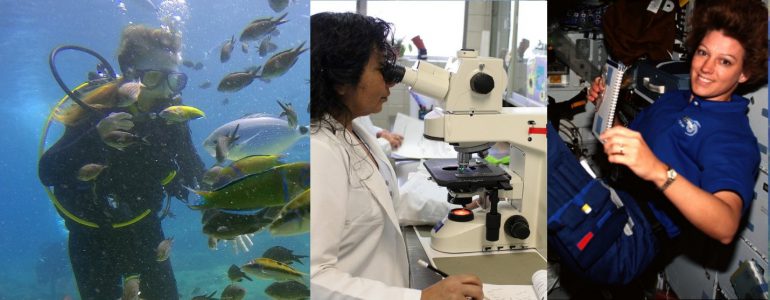On March 5, the Smithsonian kicked off its Women’s Futures Month celebration of women in STEM on the National Mall with an exhibit of 120 3-D printed statues of notable women scientists, mathematicians and engineers. Each statue has a unique QR code that links to the inspiring personal story of its subject. The exhibition runs through March 27th and is accompanied by a number of other resources designed to provide information about women in STEM and their achievements.
The exhibit has been accompanied by a number of events. On March 3, women in media were the focus of “Using Her Lens to Capture Tomorrow.” March 10 saw “Tell Me More: Living in Space” which featured MIT’s Dava Newman and her spacesuit design, the Biosuit.
“Fridays@FUTURES:#Women’sFuturesMonth” on March 11 invited participants to experience visions of the future through art while March 24 explored the power of the video game that opens video game play to players with disabilities through adaptive technology.
The Smithsonian Science Education Center offered a “Girls and Women in STEM” website where they provide STEM resources for “all students – girls and boys.” Included are activities and eBooks for download.
One of the most intriguing supporting resources is a freely downloadable PDF of the “Stories of Women in STEM at the Smithsonian.” With stories suitable for middle schoolers, the Smithsonian has used the book to introduce STEM staff with specialties ranging from those of Linda Cole, an invertebrate zoologist, to Dr. Carla Dove an ornithologist, and Shannon Brogdon-Grantham, a photo conservator. The e-book also invites readers to consider several women from the history of STEM including Margaret Knight who in 1871 patented the machine that manufactures the flat-bottomed paper bag and Dr. Chien-Shiung Wu, a physicist who worked on the Manhattan Project and became the first female president of the American Physical Society.
This exhibit and the resources around it are very important. One of the keys to a successful journey is convincing others to take the steps and face the uncertainties that always lurk around the starting point. If we can’t see ourselves as travelers along the path we are very reluctant to even begin. But if we can catch a vision of ourselves making the trek, we can muster the courage to begin.
The women depicted in these materials have not only made exemplary strides in their fields, the Smithsonian has been very open about the struggles and obstacles that they faced along the way. For example, Dr. Chien-Shiung Wu did significant work critical to the research that led to a Nobel Prize for her co-researchers, Dr. Tsung-Dao Lee and Dr. Chen-Ning Yang. Despite the importance of her contribution, Dr. Wu received no recognition for that work.
Even with the reality of their difficulties, little girls who want to “do” science or math will have no trouble identifying with the women profiled by the Smithsonian. Their achievements are exciting enough to encourage anyone with a technical bent to begin the climb to the heights the heroes have attained. The “regular” beginnings coupled with the extraordinary accomplishments make for an inviting quest with a place for other girls to travel new paths. Girls interested in STEM will be inspired with real pictures around which they can catch their vision. This makes the Smithsonian program a valuable contribution to the future of science in our society.
But, there is another, less obvious, audience, one that is arguably even more important to attaining the goal of diverse participation in the science and technology sector. That audience is made up of those of us for whom the doors of access and advancement were already open. The obstacles of effort and ability were not made more arduous by artificial burdens imposed on us because of our gender or race or ethnicity. This audience is the group that predominates among the STEM leaders of today.
What do the Smithsonian’s exhibit and resources have to say to us – the older, white men? Just as it creates a picture of the actual accomplishments of these unknown or little-known women of science to serve as a beacon for the aspirations of the female students beginning their journey to success, it provides that same picture of achievement to serve as a reality check for today’s STEM leaders. It provides a very real picture of the consequences and costs of practices that, intentionally or unintentionally, operate to exclude or impede developing women scientists on their way to achievement. The girls who are prevented from achieving at their full potential have, and will continue to include the women who might otherwise have done Nobel-quality work on subatomic particles or won a Nobel Prize in Chemistry.
By not encouraging and enabling the development of girls who would otherwise take up the STEM disciplines we are depriving society of their potential accomplishments. The Smithsonian resources make clear the nature of that loss. Just as the accomplishments of these amazing women give aspiring girls a tangible picture of what they might do, they give the rest of us a clear warning of what we might lose if we fail to encourage those girls. With this in mind we should all pull together to remove the impediments that block their way.
The Smithsonian has approached the conversation about girls and women in STEM with practical help. Their message of inspiration for young women coupled with their picture of what excluding or discouraging those aspiring scientists mathematicians and engineers costs society in terms of opportunities and potential lost, encourages all of us to take practical steps to see that our girls and boys inclined to pursue careers in STEM fields can find a smooth on-ramp to success. We should applaud the Smithsonian and visit them soon and often!
To say “thank you” or learn more: https://www.si.edu/contacts






